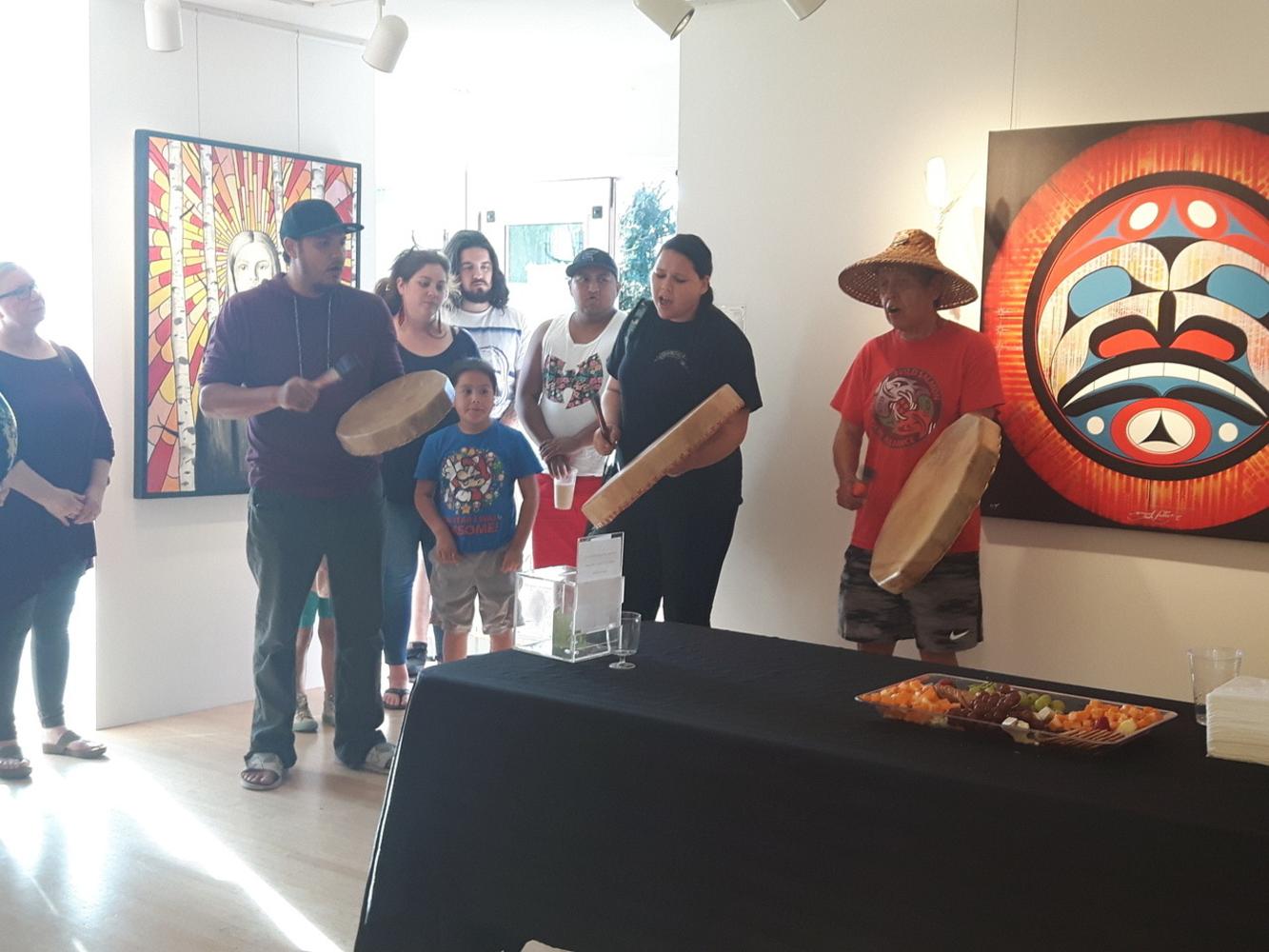Saturday, June 1 marked the opening of the Indigenous Awareness Exhibition presented by the Abbotsford Arts Council at the Kariton Art Gallery. The Kariton’s small quarters offered an intimate experience with the collection of Indigenous art on display that ranged from wooden masks to painted canvas to handmade regalia. The exhibition provided an opportunity for Indigenous artists to showcase their work and enrich the local community with their culture and history.
The event began with a short ceremony featuring drumming and singing to welcome the crowd. The energy of the evening was laid back and gallery goers were able to mingle with the artists.
Pieces which stood out included Peter Gong’s Sasquatch Mask, featuring articulate, outstretched hands and horsehair, and Moon Mask, representing the four directions and seasons as faces with abalone inlays. Both masks were carved from red cedar wood. Steven Sasiadek’s framed prints also offered brightly coloured representations of Thunderbird and Sisiutl, legendary creatures in Pacific Northwest Indigenous storytelling.
Representing his art physically, Sta’ya’akin (pronounced [sch-aya-kin], meaning a person who doesn’t leave tracks) displayed a breathtaking, handmade ensemble of moccasins, head piece, robe, and staff. His outfit symbolized his entire family history complete with deaths, adoptions, and divorces; the unapologetic openness displayed by Sta’ya’akin was both touching and refreshing. He welcomed anyone to look through a personal photo album showing traditional clothing made by him and his sons and which featured memories of his late father. During his introduction he spoke on how he felt called to do community work and connect people with Indigenous culture; a personal mantra of his is to “show up.”
“I’ve been in quite a few places where people were passing from cancer. I was brought in to sing songs to them in hospitals; I’ve been brought into hospices. For such a young man I was told I have a really old spirit [and] that’s why I’m called into these places… I don’t powwow; I don’t dance openly in ceremonies like that. I’ve been taught to go to these places where I’m really called to share our culture and bring it back to our people,” Sta’ya’akin said.
Another artist was Jo-Ann Lindahl, representing her acrylic paintings from a series she calls Through the Trees: Reflections and Reconciliation. Two of them followed a theme where they balanced the duality of monochrome, Indigenous women set against colourful backgrounds. While discussing her work, she shared her artistic process and what inspired her.
“I was really into old photographs of Indigenous females. I was searching the internet for the last couple years looking at pictures … and this one particular image spoke to me. She’s also a Blackfoot woman, and that’s where my ancestry comes from. It was the oldest photo I could find. To think that that’s maybe a distant relative of mine was really powerful to me,” Lindahl said.
All of Lindahl’s pieces featured vivid backgrounds of flat, thickly outlined blocks of colour which contrasted with the realistic human centerpieces. Lindahl spoke about the symbolism behind this and how she wields colour to represent Indigenous history.
“The bright colours in the background are meant to symbolize stained glass windows from the [Catholic] church because of the involvement of the church in residential schools. This series is a play on realistic, black and white images from history juxtaposed on the really bright, cheery, happy colours of stained glass windows because we know that the legacy of residential schools was not bright, happy, and cheery,” Lindahl said.
While some museums are expansive and encourage viewers to experience the art alone, the Indigenous Awareness Exhibition at the Kariton served as an intimate space that welcomed the community to an ongoing conversation concerning Indigenous history and traditions. The Indigenous artists showcased the beauty and significance of their work to the local art dialogue.
The Kariton Art Gallery’s visiting hours are 11:00 a.m. to 4:00 p.m. Tuesday through Saturday, with Saturday hours subject to change. This exhibition will be on display until June 25, 2019.
Image: Chandy Dancy/The Cascade
Chandy is a biology major/chemistry minor who's been a staff writer, Arts editor, and Managing Editor at The Cascade. She began writing in elementary school when she produced Tamagotchi fanfiction to show her peers at school -- she now lives in fear that this may have been her creative peak.


